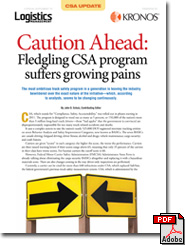Caution Ahead: Fledgling CSA program suffers growing pains
The most ambitious truck safety program in a generation is leaving the industry bewildered over the exact nature of the initiative—which, according to analysts, seems to be changing continuously.

CSA, which stands for “Compliance, Safety, Accountability,” was rolled out in phases starting in 2011. The program is designed to weed out as many as 5 percent, or 150,000 of the nation’s more than 3 million long-haul truck drivers—those “bad apples” that the government is convinced are disproportionately responsible for too many truck-related accidents and deaths.
It uses a complex system to rate the nation’s nearly 525,000 DOT-registered interstate trucking entities on seven Behavior Analysis and Safety Improvement Categories, now known as BASICs. The seven
BASICs are: unsafe driving; fatigued driving; driver fitness; alcohol and drugs; vehicle maintenance; cargo security; and crash history.
Carriers are given “scores” in each category; the higher the score, the worse the performance. Carriers are then issued warning letters if their scores range above 65, meaning that only 35 percent of the carriers in their class have worse scores. For hazmat carriers the cutoff score is 60.
However, Federal Motor Carrier Safety Administration (FMCSA) Administrator Anne Ferro is already talking about eliminating the cargo security BASICs altogether and replacing it with a hazardous materials score. There are also changes coming in the way driver-only inspections are performed.
Currently, a carrier can be cited for more than 640 infractions under CSA, which replaced SafeStat, the federal government’s previous truck safety measurement system. CSA, which is administered by the FMCSA, claims that the new enforcement program is partly responsible for a 9 percent reduction in roadside safety violations and a 12 percent drop in driver violation rates in the 18 months since CSA started.
A work in progress
To its credit, the trucking industry has largely accepted that CSA is a “work in progress.” Most industry officials have accepted it for what it is—a large government program ripe with errors, overreaches, and changes—and have credited FMCSA for being able to listen to industry gripes.
Bob Petrancosta, vice president of safety for Con-way Freight, says that he feels CSA is a worthwhile endeavor and worth the growing pains to get it right. “To FMCSA’s credit, they’re listening to the industry, enforcement community, and stakeholders,” he says.
Longtime trucking analyst John Larkin, managing director for research at Stifel Nicolaus, says flatly that CSA is “not ready for prime time,” adding: “FMCSA hasn’t done a stellar job of implementing CSA, but that is par for the course for federal programs.”
“FMCSA is in the early stages of efforts to better educate shippers, insurers, and other stakeholders about FMCSA’s publicly available motor carrier performance and regulatory compliance data sources,” says an FMCSA spokeswoman who spoke on background. She added that the administration is “committed to continually improving and refining” the relevant truck safety statistics “as better technology, new data, and continuing analysis provide the means and opportunity for refinement.”
No one is questioning the need for greater truck safety. In fact, truck-related fatalities per 100 million miles traveled are at their second-lowest point since the government began compiling that data in 1975.
But in what the industry says is a statistical quirk largely attributable to more trucks on the highways, truck-related fatalities actually rose slightly last year in the first months CSA was implemented.
Truck-related crashes spiked in 2011 by 9.4 percent over 2010’s figures according to preliminary DOT figures. The number of truck-related fatalities rose 8.7 percent to 3,675, compared with a record-low of 3,380 in 2010, according to numbers compiled by the National Highway Traffic Safety Administration.
Jury awards in truck fatality cases have exceeded $20 million in some recent cases, so trucking industry officials say it’s in their own best interest to run as safely as possible. Here’s an update on how the CSA roll out is going so far.
Implementation uneven
FMCSA officials say CSA is improving safety performance and that will be shown in future truck fatality statistics. Roadside inspection violations have declined by 9 percent in the 12 months after the launch of the new safety rating system.
Still, and not surprisingly given Washington’s record of large federal government rollouts, the first of CSA’s voluminous regulations have been implemented more slowly than first anticipated with much ambiguity and confusion. For one thing, only five of the seven BASIC scores are available on the CSA website.The cargo security and crash history BASICs, arguably the two most important factors in determining a carrier’s safety fitness, are not available to shippers on the website at this time, and there is no definite word on when they will be.
This suggests that the public should use the scores to determine a carrier’s fitness and to select carriers even though the FMCSA suggests otherwise.
“Why were the scores revealed if they were not to be used by shippers and brokers?” Larkin asks. It’s a legitimate question to which there doesn’t seem to be a logical answer. However, there is as a “disclaimer” on the FMCSA website that states that scores should not be used to “draw conclusions about a carrier’s overall safety condition.”
Effects so far
The threat of eliminating as many as 150,000 drivers at a time of growing freight demand and a tight qualified driver pool is already having an impact on rates, analysts and carriers report.
“The CSA seems to be one of the factors contributing to rate increases that carriers are still receiving even though the economy’s growth rate has been disappointing,” Larkin says. He adds that “nearly every carrier” talks of difficulty in securing an adequate number of drivers. The exceptions would be those carriers with well-developed driver training schools or relationships with a network of driver training schools, he says.
“It is, of course, always difficult to isolate the impact of one factor in a multi-factor world, but CSA seems to be making the driver shortage more acute by essentially blackballing those drivers with chronic safety problems,” says Larkin, who estimates that is perhaps 2 percent to 3 percent of the driver workforce, or as many as 75,000 drivers.
Combined with possible hours-of-service revisions and the upcoming electronic on-board recorders mandate, CSA is adding to reduced productivity and a smaller driver pool, thereby exacerbating the shortage of capacity issue within trucking, Larkin adds.
The road ahead
Trucking industry officials are continuing to press the FMCSA to fine-tune some of its methodologies, especially how non-preventable accidents and hazmat violations are counted in the scores. However, they were disappointed when FMCSA Administrator Ferro recently delayed plans to implement changes that would have allowed truckers to seek an accountability review of crashes against their safety record.
“If we’re going to be held accountable for crash scores, we want to make sure it’s a fair representation,” says Con-way’s Petrancosta. “They made a promise on accountability, but now they seem to be delaying the process.”
Going forward, CSA wants to expand its actionable data in its own rating system called SMS, or Statistical Measurement System. The agency says it has enough data to assess about 200,000 of the 525,000 active interstate motor carriers in at least one BASIC category. Those 200,000 carriers are involved in over 90 percent of all interstate commercial motor vehicle crashes, the FMCSA says.
In late March the FMCSA was scheduled to release a preview of SMS that includes enhancements that the agency is proposing to fully implement this summer. This preview will enable motor carriers to review their data and understand the impacts these changes may have on their BASIC percentiles. A new version of SMS will be released to the public this July, the spokeswoman adds.
Additionally, FMCSA is developing a Notice of Proposed Rulemaking (NPRM) for a new process to rate motor carriers called the Safety Fitness Determination. The proposed future process would incorporate roadside performance (via SMS) along with serious violations discovered during investigations to determine carriers that are unfit to operate. The agency plans to have the NPRM published late this year.

Article Topics
Special Reports News & Resources
Warehouse/DC Automation & Technology: It’s “go time” for investment 31st Annual Study of Logistics and Transportation Trends Warehouse/DC equipment survey: It’s “go time” for investment Global Logistics/3PL Special Digital Issue 2022 Motor Freight 2022: Pedal to the Metal Top 50 Trucking Companies: The strong get stronger 2019 Top 50 Trucking Companies: Working to Stay on Top More Special ReportsLatest in Logistics
LM Podcast Series: Assessing the freight transportation and logistics markets with Tom Nightingale, AFS Logistics Investor expectations continue to influence supply chain decision-making The Next Big Steps in Supply Chain Digitalization Warehouse/DC Automation & Technology: Time to gain a competitive advantage The Ultimate WMS Checklist: Find the Perfect Fit Under-21 driver pilot program a bust with fleets as FMCSA seeks changes Diesel back over $4 a gallon; Mideast tensions, other worries cited More LogisticsSubscribe to Logistics Management Magazine

Find out what the world's most innovative companies are doing to improve productivity in their plants and distribution centers.
Start your FREE subscription today.
April 2023 Logistics Management

Latest Resources















